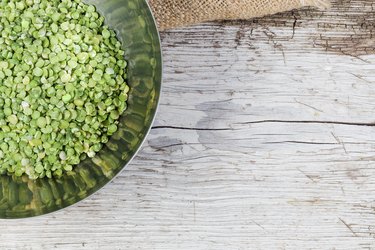
While canned, ready-to-eat split pea soup might taste good, it has some nutritional downsides. By preparing homemade split pea soup, nutrition can improve significantly.
In addition, you can experiment with vegetarian versions and include vegetables such as carrots, celery and onions for extra nutrients and fiber.
Video of the Day
Video of the Day
Read more: The Nutritional Value of Yellow Split Peas
Low in Fat
A typical 1-cup serving of split pea soup that contains chopped ham from ham hocks, ham shanks or diced boneless ham has approximately 220 split pea soup calories, and about 32 of these calories come from fat, according to the USDA. Split pea soup with ham may contain around 1 gram of saturated fat and 15 milligrams of cholesterol. By contrast, split pea soup prepared without ham has 169 calories, no cholesterol and only 1 gram of fat, according to the USDA.
Get Your Fiber
Split peas, like other legumes, are high in fiber, and split pea soup is a good source of complex carbohydrates, especially homemade versions that include plenty of chopped vegetables. The carbs in split pea soup clock in at 30 grams. One cup of vegetarian split pea soup contains 11 grams of fiber, according to the USDA. This goes a long way toward meeting the daily recommended intake of 25 grams for women and 38 grams for men, according to the National Academies of Sciences.
This nutrient is important for digestive health and can reduce risk of heart disease and help control blood sugar levels, according to Harvard School of Public Health. The soup is naturally low in sugar, with only 5 grams in every cup.
Split Pea Soup Protein Varies
If you make homemade split pea soup with ham, each 1-cup serving will typically contain between 25 and 35 grams of protein, making it an extremely high-protein dish. Vegetarian versions of the soup contain less protein: approximately 7 grams per 1-cup serving. Split peas are not a complete protein, though as long as you consume a variety of grains and produce throughout the rest of the day, you'll be able to meet all of your protein needs without animal-based products.
Read more: Pea Protein Side Effects
Promote Eye Health
Vitamin A is important for vision, according to Harvard Health Publishing. This vitamin is needed for the production of rhodopsin, a visual pigment that allows the visual receptors in your eyes to detect light. Without adequate vitamin A, you'll be more likely to develop night blindness or eye disorders that can lead to permanent vision loss.
A 1-cup serving of split pea soup may contain close to 2,500 international units of vitamin A, or more than 50 percent of the amount of the nutrient healthy men and women need each day. Split pea soup also contains smaller amounts of vitamins such as folate and vitamin C.
Lower Your Blood Pressure
Legumes and vegetables are high in potassium, and each cup of homemade split pea soup may supply over 20 percent of the recommended daily intake of the mineral for adults. The Linus Pauling Institute reports that a diet rich in potassium may help lower your risk of high blood pressure.
To maximize the benefits you can receive from the potassium in split pea soup, keep your sodium intake under control — eating too much sodium and too little potassium may increase your chance of developing heart disease. Use low- or no-sodium broth when preparing split pea soup and avoid adding salt at the table.